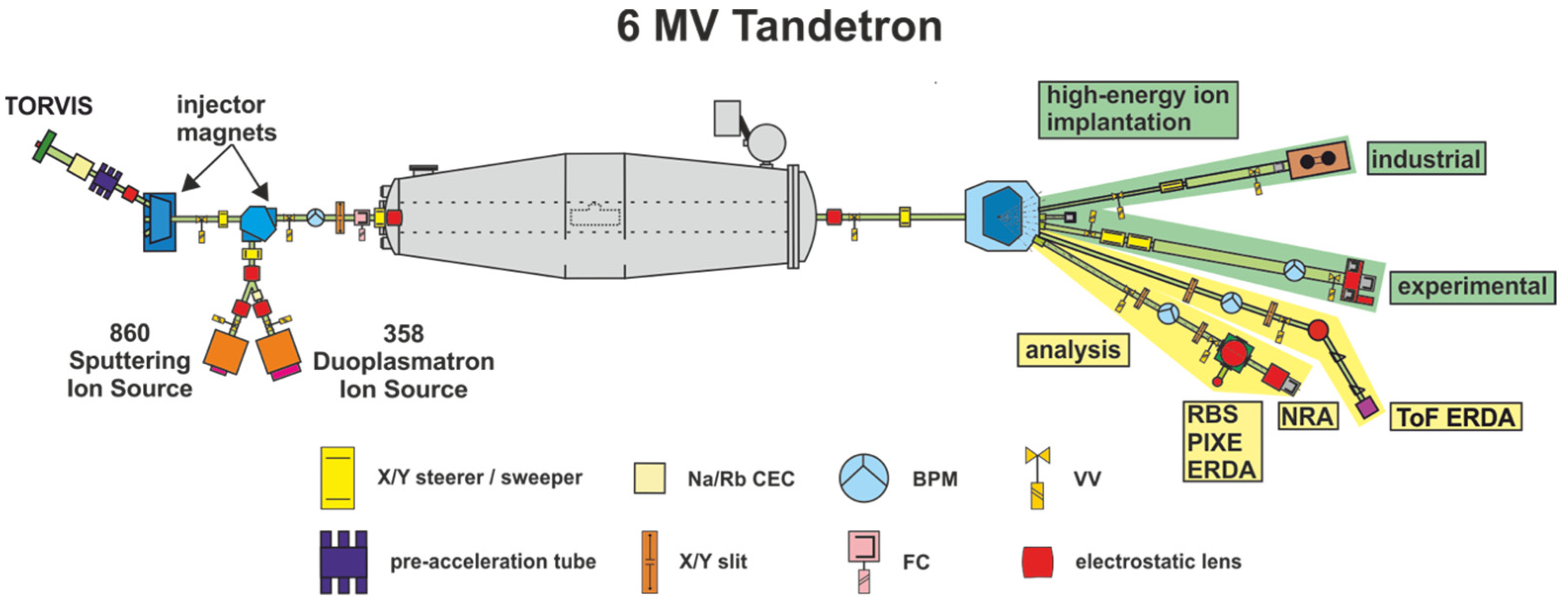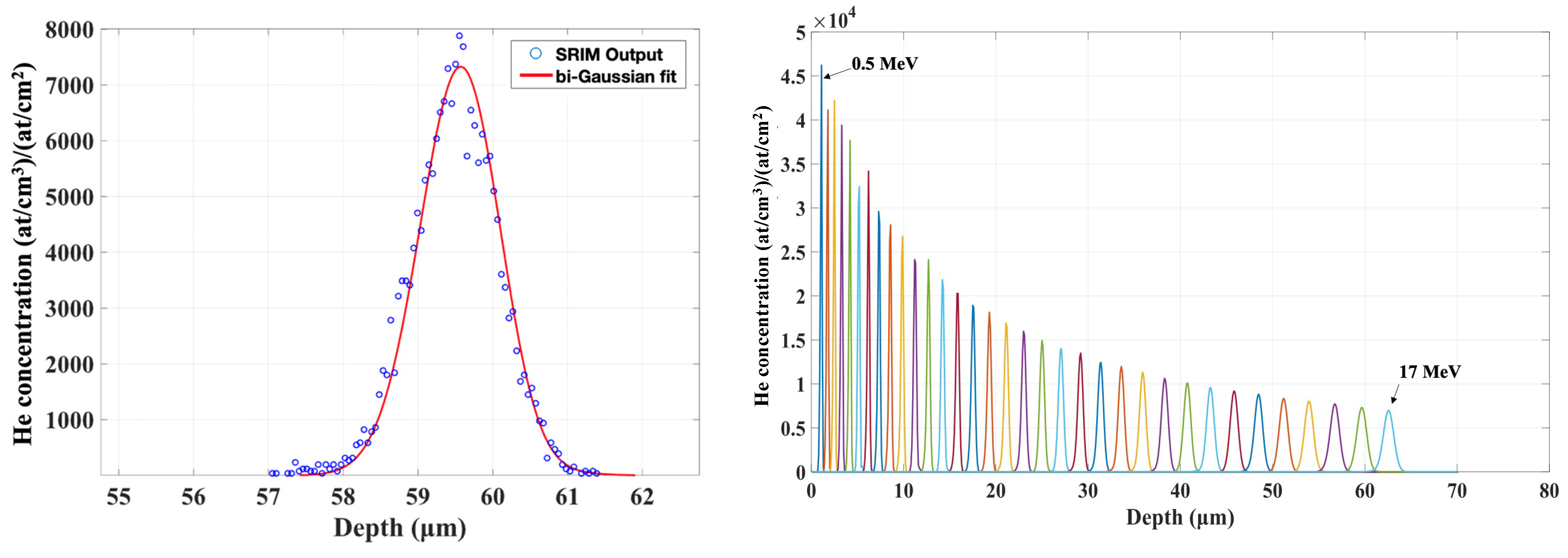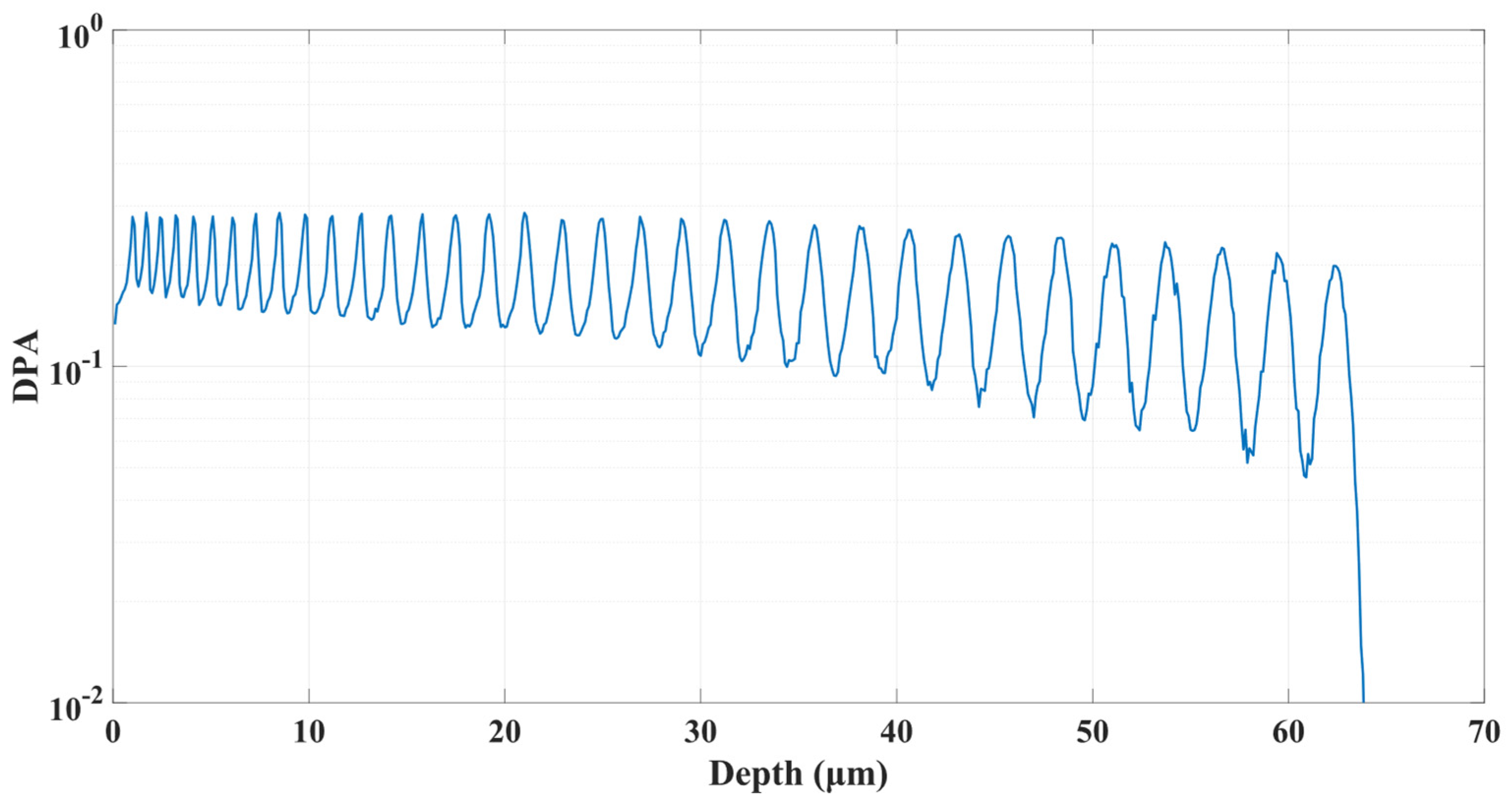High-Fluence Multi-Energy Ion Irradiation for Testing of Materials
Abstract
1. Introduction
2. Materials and Methods
2.1. Equipment
2.2. Multi Energy Sequential Irradiation Experiment Design
3. Results and Discussion
3.1. Upgraded Equipment
3.2. High-Fluence Helium Irradiation
4. Conclusions
Author Contributions
Funding
Institutional Review Board Statement
Informed Consent Statement
Acknowledgments
Conflicts of Interest
References
- DOENE. A Technology Roadmap for Generation IV Nuclear Energy Systems; DOENE (USDOE Office of Nuclear Energy, Science and Technology (NE)): Washington, DC, USA, 2002. [Google Scholar] [CrossRef]
- Stanculescu, A. GIF R&D Outlook for Generation IV Nuclear Energy Systems: 2018 Update. In Proceedings of the Generation IV International Forum, Paris, France, 16–18 October 2018; p. 96. Available online: https://www.gen-4.org/gif/jcms/c_108744/gif-r-d-outlook-for-generation-iv-nuclear-energy-systems-2018-update (accessed on 16 August 2022).
- Zinkle, S.J.; Snead, L.L. Designing Radiation Resistance in Materials for Fusion Energy. Annu. Rev. Mater. Res. 2014, 44, 241–267. [Google Scholar] [CrossRef]
- Wheldon, C. Applications in Nuclear Physics and Nuclear Industry. In Proceedings of the PSD12: The 12th International Conference on Position Sensitive Detectors, Birmingham, UK, 12–17 September 2021; Available online: https://indico.cern.ch/event/797047/contributions/3638201/ (accessed on 16 August 2022).
- University of Birmingham. High Flux Accelerator-Driven Neutron Facility. Available online: https://www.birmingham.ac.uk/research/activity/nuclear/about-us/facilities/high-flux-neutron-facility.aspx (accessed on 16 August 2022).
- Bernardi, D.; Arbeiter, F.; Cappelli, M.; Fischer, U.; García, A.; Heidinger, R.; Krolas, W.; Martín-Fuertes, F.; Miccichè, G.; Muñoz, A.; et al. Towards the EU fusion-oriented neutron source: The preliminary engineering design of IFMIF-DONES. Fusion Eng. Des. 2019, 146, 261–268. [Google Scholar] [CrossRef]
- ESFRI. ESFRI Roadmap 2021 Strategy Report on Research Infrastructures; Departmento di Fisica—Università degli Studi di Milano: Milan, Italy, 2021; p. 172. ISBN 978-88-943243-6-5. Available online: https://roadmap2021.esfri.eu/media/1295/esfri-roadmap-2021.pdf (accessed on 16 August 2022).
- Jepeal, S.J.; Danagoulian, A.; Kesler, L.A.; Korsun, D.A.; Lee, H.Y.; Schwartz, N.; Sorbom, B.N.; Velez Lopez, E.; Hartwig, Z.S. An accelerator facility for intermediate energy proton irradiation and testing of nuclear materials. Nucl. Instrum. Meth. Phys. Res. B 2021, 489, 41–49. [Google Scholar] [CrossRef]
- Hosemann, P. Small-scale mechanical testing on nuclear materials: Bridging the experimental length-scale gap. Scripta Mater. 2018, 143, 161–168. [Google Scholar] [CrossRef]
- Rayaprolu, R.; Möller, S.; Linsmeier, C.; Spellerberg, S. Simulation of neutron irradiation damage in tungsten using higher energy protons. Nucl. Mater. Energy 2016, 9, 29–35. [Google Scholar] [CrossRef][Green Version]
- Was, G.S. Challenges to the use of ion irradiation for emulating reactor irradiation. J. Mater. Res. 2015, 30, 1158–1182. [Google Scholar] [CrossRef]
- Krsjak, V.; Shen, T.; Degmova, J.; Sojak, S.; Korpas, E.; Noga, P.; Egger, W.; Li, B.; Slugen, V.; Garner, F.A. On the helium bubble swelling in nano-oxide dispersion-strengthened steels. J. Mater. Sci. Technol. 2022, 105, 172–181. [Google Scholar] [CrossRef]
- Garner, F.A. Impact of the injected interstitial on the correlation of charged particle and neutron-induced radiation damage. J. Nucl. Mater. 1983, 117, 177–197. [Google Scholar] [CrossRef]
- Was, G.S.; Jiao, Z.; Getto, E.; Sun, K.; Monterros, A.M.; Maloy, S.A.; Anderoglu, O.; Sencer, B.H.; Hackett, M. Emulation of reactor irradiation damage using ion beams. Scr. Mater. 2014, 88, 33–36. [Google Scholar] [CrossRef]
- Gigax, J.G.; Kim, H.; Chen, T.; Garner, F.A.; Shao, L. Radiation instability of equal channel angular extruded T91 at ultra-high damage levels. Acta Mater. 2017, 132, 395–404. [Google Scholar] [CrossRef]
- Shao, L.; Wei, C.-C.; Gigax, J.; Aitkaliyeva, A.; Chen, D.; Sencer, B.H.; Garner, F.A. Effect of defect imbalance on void swelling distributions produced in pure iron irradiated with 3.5 MeV self-ions. J. Nucl. Mater. 2014, 453, 176–181. [Google Scholar] [CrossRef]
- Kumar, N.A.P.K.; Li, C.; Leonard, K.J.; Bei, H.; Zinkle, S.J. Microstructural stability and mechanical behavior of FeNiMnCr high entropy alloy under ion irradiation. Acta Mater. 2016, 113, 230–244. [Google Scholar] [CrossRef]
- Krsjak, V.; Degmova, J.; Noga, P.; Petriska, M.; Sojak, S.; Saro, M.; Neuhold, I.; Slugen, V. Application of positron annihilation spectroscopy in accelerator-based irradiation experiments. Materials 2021, 14, 6238. [Google Scholar] [CrossRef] [PubMed]
- Shiau, C.-H.; Sun, C.; McMurtrey, M.; O’Brien, R.; Garner, F.A.; Shao, L. Orientation-selected micro-pillar compression of additively manufactured 316L stainless steels: Comparison of as-manufactured, annealed, and proton-irradiated variants. J. Nucl. Mater. 2022, 566, 153739. [Google Scholar] [CrossRef]
- Noga, P.; Dobrovodský, J.; Vaňa, D.; Beňo, M.; Závacká, A.; Muška, M.; Halgaš, R.; Minárik, S.; Riedlmajer, R. A new ion-beam laboratory for materials research at the Slovak University of Technolog. Nucl. Insturm. Meth. Phys. Res. B 2017, 409, 264–267. [Google Scholar] [CrossRef]
- Hauser, T.M.; Daniel, R.E.; Norton, G.A.; Schroeder, J.B. High current He- injector for tandem accelerators. Nucl. Instrum. Meth. Phys. Res. B 2006, 249, 932–934. [Google Scholar] [CrossRef]
- Dobrovodský, J.; Beňo, M.; Vaňa, D.; Bezák, P.; Noga, P. The first year operation experience with Ion Beam Analysis at the new STU Ion Beam Laboratory. Nucl. Insturm. Meth. Phys. Res. B 2019, 450, 168–172. [Google Scholar] [CrossRef]
- Laitinen, M.; Rossi, M.; Julin, J.; Sajavaara, T. Time-of-flight—Energy spectrometer for elemental depth profiling—Jyväskylä design. Nucl. Insturm. Meth. Phys. Res. B 2014, 337, 55–61. [Google Scholar] [CrossRef]
- Wu, H.; Böttger, R.; Couffignal, F.; Gutzmer, J.; Krause, J.; Munnik, F.; Renno, A.D.; Hübner, R.; Wiedenbeck, M.; Ziegenrücker, R. ‘Box-Profile’ Ion Implants as Geochemical Reference Materials for Electron Probe Microanalysis and Secondary Ion Mass Spectrometry. Geostand. Geoanal. Res. 2019, 43, 531–541. [Google Scholar] [CrossRef]
- Ziegler, J.F.; Ziegler, M.D.; Biersack, J.P. SRIM—The stopping and range of ions in matter. Nucl. Insturm. Meth. Phys. Res. B 2010, 268, 1818–1823. [Google Scholar] [CrossRef]
- Stoller, R.E.; Toloczko, M.B.; Was, G.S.; Certain, A.G.; Dwaraknath, S.; Garner, F.A. On the use of SRIM for computing radiation damage exposure. Nucl. Insturm. Meth. Phys. Res. B 2013, 310, 75–80. [Google Scholar] [CrossRef]
- Norgett, M.J.; Robinson, M.T.; Torrens, I.M. A proposed method of calculating displacement dose rates. Nucl. Eng. Des. 1975, 33, 50–54. [Google Scholar] [CrossRef]
- Brimbal, D.; Meslin, E.; Henry, J.; Décamps, B.; Barbu, A. He and Cr effects on radiation damage formation in ion-irradiated pure iron and Fe-5.40 wt.% Cr: A transmission electron microscopy study. Acta Mater. 2013, 61, 4757–4764. [Google Scholar] [CrossRef]
- Radiation Safety Report on Radiation Shielding Test of CAMBO Ion Beam Centre Building; Slovak University of Technology: Bratislava, Bratislava, 2015.





Publisher’s Note: MDPI stays neutral with regard to jurisdictional claims in published maps and institutional affiliations. |
© 2022 by the authors. Licensee MDPI, Basel, Switzerland. This article is an open access article distributed under the terms and conditions of the Creative Commons Attribution (CC BY) license (https://creativecommons.org/licenses/by/4.0/).
Share and Cite
Noga, P.; Száraz, Z.; Kubiš, M.; Dobrovodský, J.; Ferenčík, F.; Riedlmajer, R.; Krsjak, V. High-Fluence Multi-Energy Ion Irradiation for Testing of Materials. Materials 2022, 15, 6443. https://doi.org/10.3390/ma15186443
Noga P, Száraz Z, Kubiš M, Dobrovodský J, Ferenčík F, Riedlmajer R, Krsjak V. High-Fluence Multi-Energy Ion Irradiation for Testing of Materials. Materials. 2022; 15(18):6443. https://doi.org/10.3390/ma15186443
Chicago/Turabian StyleNoga, Pavol, Zoltán Száraz, Matej Kubiš, Jozef Dobrovodský, Filip Ferenčík, Róbert Riedlmajer, and Vladimir Krsjak. 2022. "High-Fluence Multi-Energy Ion Irradiation for Testing of Materials" Materials 15, no. 18: 6443. https://doi.org/10.3390/ma15186443
APA StyleNoga, P., Száraz, Z., Kubiš, M., Dobrovodský, J., Ferenčík, F., Riedlmajer, R., & Krsjak, V. (2022). High-Fluence Multi-Energy Ion Irradiation for Testing of Materials. Materials, 15(18), 6443. https://doi.org/10.3390/ma15186443





